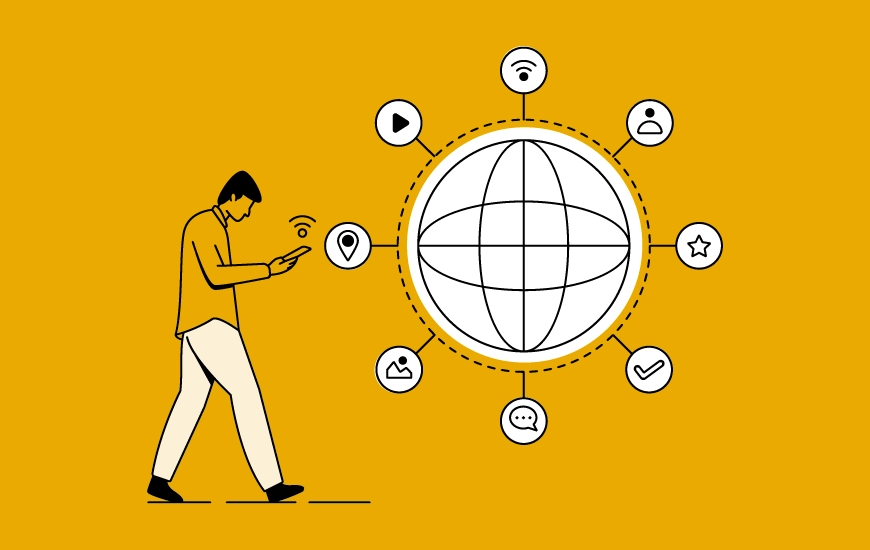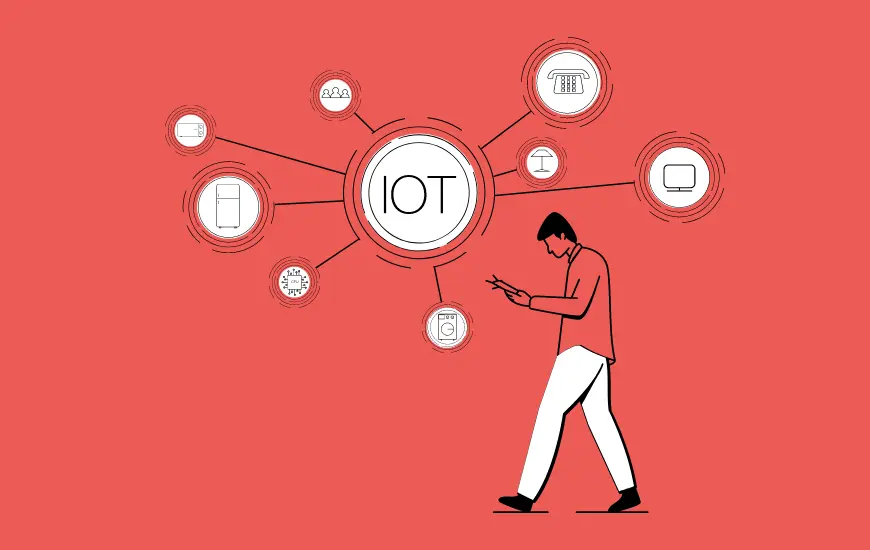- What is IoT in Aerospace?
- Benefits of IoT in Aviation
- Predictive Maintenance
- Operational Efficiency
- Cost Reduction
- Enhanced Safety
- Improved Passenger Experience
- Asset Tracking and Management
- Optimized Air Traffic Management
- Environmental Monitoring
- Data-Driven Decision-Making
- Use Cases of IoT in Aviation
- Condition-Based Monitoring for Aircraft Engines
- Connected Aircraft Systems
- Baggage Tracking and Management
- Smart Airport Infrastructure
- Wireless Sensor Networks for Aircraft Health Monitoring
- Predictive Analytics for Component Health
- In-Flight Connectivity and Entertainment
- Air Traffic Flow Optimization
- Environmental Monitoring at Airports
- Issues and Challenges of IoT Adoption In Aviation
- Cybersecurity Concerns
- Hidden Attacks
- Mirroring Attacks
- Imitation Attacks
- Physical Risks
- Software/Network Security Risks
- How to Implement IoT in Aviation?
- Ideation and Strategy
- Pilot and Roadmap
- Capture, Store, and Process
- Scale and Deploy
- Operate
- Conclusion
- FAQ’s
In the aviation sector, technological advancements continually reshape the industry’s operations. One revolutionary innovation that has gained substantial popularity is the Internet of Things (IoT). In 2022, the IoT in Aviation market has already made a significant impact, amounting to $1.57 billion. The future outlook is even more promising, with a projected increase to $6.40 billion by 2029, showcasing an impressive CAGR of 19.2%.
The integration of IoT technology in the aviation industry presents a vast array of possibilities. It improves operational efficiency and also revolutionizes the passenger experience. Nevertheless, like any transformative innovation, IoT implementation comes with its fair share of benefits and challenges. This article explores the diverse use cases, highlights the compelling advantages, and addresses the potential obstacles associated with embracing IoT in aviation.
What is IoT in Aerospace?
The integration of interconnected devices and systems in aviation through the Internet of Things (IoT) brings about a transformational impact. It significantly enhances operational efficiency, safety measures, and the overall passenger experience. By embedding sensors in aircraft components, real-time monitoring, predictive maintenance, and proactive issue resolution are made possible.
This technology also extends to fuel management, optimizing consumption through the analysis of real-time data. Asset tracking solutions improve ground operations by providing monitoring capabilities for valuable resources, such as location and status. Smart airport solutions revolutionize the passenger experience by offering personalized services and real-time updates.
Safety and security are further ensured through IoT-enabled surveillance systems, while air traffic management benefits from enhanced communication between aircraft and control systems. Cabin connectivity enhances in-flight experiences, providing entertainment options and personalized services.
Moreover, environmental monitoring contributes to a comfortable and sustainable travel environment. The importance of IoT in aviation continues to redefine processes, ensuring a seamless journey that is efficient and secure for passengers while optimizing overall operations.
Benefits of IoT in Aviation
The IoT in aviation industry offers various advantages that greatly enhance various facets of the sector. Here are some benefits of leveraging IoT in aviation:

Predictive Maintenance
The integration of IoT in aviation industry enables real-time monitoring of aircraft components, facilitating predictive maintenance. By proactively identifying potential issues, airlines can take timely measures to minimize downtime, reduce maintenance costs, and enhance the reliability of their fleet.
Operational Efficiency
The IoT technology in the aviation industry enables airlines to streamline their operations by leveraging data-driven decision-making. By obtaining real-time insights on fuel consumption, asset tracking, and aircraft health, airlines gain the ability to allocate resources efficiently, optimizing overall operational processes and effectively managing airport facilities.
Cost Reduction
In the aviation industry, the integration of IoT technology enables predictive maintenance and optimized operations. This, in turn, leads to tangible cost reductions. By minimizing downtime and enhancing fuel efficiency, airlines can achieve substantial savings in maintenance and operational expenses.
Enhanced Safety
Enhanced aviation safety is achieved through real-time monitoring of critical parameters, including engine performance and weather conditions. The utilization of IoT enables the implementation of advanced surveillance systems, playing a significant role in accident prevention and fostering safety advancements throughout the industry.
Improved Passenger Experience
The incorporation of IoT-powered smart airport solutions revolutionizes the passenger experience, offering real-time updates, personalized services, and streamline travel processes. This leads to increased satisfaction among travelers, who also benefit from enhanced entertainment options through in-flight connectivity, further augmenting their overall journey.
Asset Tracking and Management
The aviation industry benefits greatly from the implementation of IoT, as it enables accurate tracking and efficient management of valuable assets. Whether it’s luggage carts or maintenance equipment, leveraging IoT-driven asset tracking results in optimized utilization, reduced losses, and enhanced operational efficiency on the ground.
Optimized Air Traffic Management
The optimization of air traffic management greatly relies on the integration of IoT technologies. By enhancing communication and data exchange between aircraft and air traffic control systems, IoT effectively minimizes delays, improves the flow of air traffic, and contributes to the overall efficiency of airspace management.
Environmental Monitoring
Dedicated Internet of Things (IoT) devices used for monitoring environmental factors such as air quality and noise levels play a crucial role in creating a comfortable and sustainable travel environment. By utilizing real-time data, airlines can incorporate eco-friendly practices that align with their environmental sustainability goals and promote corporate responsibility.
Data-Driven Decision-Making
The aviation industry benefits greatly from the huge amount of data produced by IoT devices. This data provides valuable insights for making data-driven decisions. Airlines and aviation authorities are able to utilize this data to inform strategic planning, optimize performance, and drive continuous improvement initiatives throughout the sector.
Use Cases of IoT in Aviation
The Internet of Things (IoT) has proven to be immensely valuable in the aviation industry, offering practical applications across various sectors. Its implementation has resulted in tangible benefits for this sector. To illustrate the real-world impact of IoT for aviation, let’s explore some specific applications of IoT in aviation.

Condition-Based Monitoring for Aircraft Engines
A practical real world applications of IoT in aviation is Rolls-Royce’s “Engine Health Monitoring” system. This innovative system utilizes a network of IoT sensors embedded in aircraft engines. These sensors continuously monitor crucial parameters like temperature, pressure, and vibration. The collected data is then promptly transmitted in real-time to ground control.
This enables engineers to assess the health of the engine and anticipate potential issues beforehand. By adopting this proactive approach, airlines can schedule maintenance with precision, minimizing downtime and maximizing the overall reliability of their fleet.
Connected Aircraft Systems
In a real-life scenario, the advanced systems of Boeing’s 787 Dreamliner take center stage. This remarkable aircraft boasts a network of interconnected components. Utilizing Internet of Things (IoT) sensors, it collects essential data related to navigation, flight control, and communication systems. The data is constantly updated and made readily available to both pilots and ground control, allowing them to make well-informed decisions.
Baggage Tracking and Management
One of the most notable real-world examples is Delta Air Lines’ implementation of an advanced baggage handling system that utilizes RFID technology. With this innovative system in place, each piece of luggage is equipped with an RFID tag, enabling real-time tracking throughout its entire journey. Passengers can conveniently stay updated about the location of their belongings through mobile apps. This comprehensive approach minimizes the risk of mishandled baggage and also optimizes operational efficiency by streamlining the entire baggage handling process.
Smart Airport Infrastructure
Amsterdam Airport Schiphol, as a real-world example, has adopted the implementation of smart infrastructure to optimize the operations within the airport. To monitor the condition of critical infrastructure such as escalators, conveyors, and HVAC systems, the airport has deployed IoT sensors.
These sensors collect data, which is then analyzed by predictive maintenance algorithms. The algorithms detect potential issues before they can lead to disruptions. By adopting this proactive maintenance approach, the airport minimizes downtime, improves efficiency, and enhances the overall passenger experience.
Wireless Sensor Networks for Aircraft Health Monitoring
Airbus utilizes wireless sensor networks for comprehensive aircraft health monitoring. These networks consist of sensors strategically placed throughout the aircraft’s structure to detect any signs of stress, fatigue, or damage. The data collected is transmitted in real-time, allowing maintenance teams to address potential structural issues promptly. This application of IoT enhances overall safety and prolongs the lifespan of the aircraft.
Predictive Analytics for Component Health
Southwest Airlines has implemented an innovative predictive maintenance strategy relying on data collected from sensors throughout their aircraft. Insights from Internet of Things technology monitor engines, landing gear, and other vital systems, analyzing component performance to foresee maintenance or replacement needs before issues arise. By proactively determining optimal schedules based on predictive insights, costs are reduced while reliability across the fleet is ensured. This approach supports Southwest’s commitment to operational excellence through data-driven anticipation of equipment needs.
In-Flight Connectivity and Entertainment
Panasonic Avionics’ eXConnect system shows how the Internet of Things improves air travel. This technology enables consistent connectivity through satellite systems, permitting travelers to access the internet, stream media, and remain in contact during flights. Moreover, the solution exploits data examination to propose customized material suggestions tailored to every passenger’s taste.
Air Traffic Flow Optimization
In the United States, the Federal Aviation Administration’s NextGen program serves as a prime example of how IoT is employed to optimize air traffic flow. This comprehensive initiative utilizes data from sensors on aircraft, weather stations, and air traffic control systems to dynamically adjust flight routes. By taking a proactive approach, this program effectively reduces congestion, minimizes delays, and enhances overall airspace management. Consequently, it contributes to a more efficient and safer air transportation system.
Environmental Monitoring at Airports
Hong Kong International Airport employs Internet of Things (IoT) devices to monitor the environment. By utilizing sensors, they are able to measure air quality, noise levels, and various other environmental factors throughout the airport. The data collected in real-time is then utilized to implement necessary adjustments, such as fine-tuning ventilation systems or deploying noise barriers, in order to ensure a comfortable environment for passengers. Moreover, these valuable insights help in the airport’s sustainability initiatives by identifying areas for improvement in resource consumption and minimizing their environmental impact.
Issues and Challenges of IoT Adoption In Aviation
The IoT in aviation industry offers numerous benefits, such as streamlining processes, minimizing human intervention, saving time, ensuring precision, and providing real-time information, but it has also introduced new concerns regarding safeguarding information from cyber threats.

Cybersecurity Concerns
The aviation sector has encountered a notable challenge due to the integration of ICT tools. With the advent of smart aviation concepts, the industry now encounters cybersecurity concerns. Issues like data theft, hacking, and the potential misuse of information for illicit purposes must be effectively addressed.
Hidden Attacks
In cybersecurity, there is a specific challenge that arises when hidden attacks occur. These attacks involve a deluge of random IP addresses targeting the data operation center. This overwhelming flood of information creates a state of confusion, making it difficult for the center to distinguish between legitimate and illegitimate IPs. This emphasizes the critical need for robust cybersecurity measures to combat such threats.
Mirroring Attacks
Mirroring attacks pose serious threats as the victim’s IP address is shared with unknown sources. This unauthorized sharing of sensitive information emphasizes the need for heightened security measures to prevent illicit data exposure.
Imitation Attacks
Imitation attacks refer to the unauthorized use of a legitimate user’s identity by an attacker who assumes their IP address to impersonate them. This type of cyber attack has the potential to cause significant harm, making it crucial to accurately detect these attacks in order to minimize the impact on both the victim and the company.
Physical Risks
When internet-connected devices are introduced into physical objects, safety issues can arise. If things go wrong due to small problems like temporary power losses or overheating components, users may face risks that the technology alone cannot fix. While technology provides benefits, its integration with real-world items means we must consider how to keep people safe from unexpected issues outside direct digital control.
Software/Network Security Risks
While software updates are crucial for internet-connected devices, insufficient upgrades can potentially endanger users. Unauthorized alterations or corrupted code threatens clients reliant on certain Application Programming Interfaces. Moreover, an IoT system’s dependence on network connections renders it vulnerable to bandwidth interference.
This may disrupt communication, result in lost or inaccurate transmissions, introduce technical glitches, and cause other malfunctions. Therefore, keeping IoT applications and their associated software secure through regular, well-tested improvements is paramount to safeguard data integrity and shield clients from potential security breaches introduced by outdated or modified code.
Related read: How to Ensure Cybersecurity in the Age of IoT
How to Implement IoT in Aviation?
Careful planning and execution are essential when introducing IoT in aviation airports. The process can be divided into five manageable management steps.
Ideation and Strategy
To successfully implement IoT in aerospace industry, the first step involves aligning your business strategy with specific targets and areas for improvement. Leverage ideation workshops and collaborate with ecosystem contacts to explore innovative solutions beyond traditional approaches. Foster a culture that encourages trial and error, promoting a mindset of experimentation within the organization.
Pilot and Roadmap
Once a well-defined strategy is in place, the subsequent step involves piloting your IoT initiatives. It is crucial to highlight the significance of rapid learning and iteration throughout the process. It is advisable to avoid excessive planning as it may impede innovation.
A governance plan must be developed, accompanied by the establishment of a structured framework. It is important to conduct risk assessments and analyze capabilities. While planning is essential, it is important to avoid falling into the trap of inaction. Instead, shift focus towards making progress and advancing with your roadmap.
Capture, Store, and Process
To ensure the success of IoT in aerospace industry, it is essential to establish effective mechanisms for capturing accurate data. One way to achieve this is by utilizing both edge computing and cloud technology, which enables efficient data processing and storage. Additionally, implementing robust systems for data analysis is crucial as it allows you to derive meaningful insights from the information collected. This stage plays an essential role of IoT in aviation to extract valuable knowledge from the data generated by your IoT devices.
Scale and Deploy
Once the concept has been validated through successful trial runs, it is important to shift focus towards achieving scalability. Factors such as privacy rules, security measures, and global capabilities should be taken into consideration. It is crucial to ensure compliance with regulations and standards as you expand your IoT initiatives. This crucial step will help you extend the impact of your IoT implementation while also addressing any challenges that may arise during growth.
Operate
Once set up, it is important to continuously monitor how your Internet of Things (IoT) projects are performing. Be sure to regularly check how well everything is functioning and evaluate how much your IoT efforts are helping key business results. Strive for ongoing improvements by pinpointing possibilities for positive change, duplicating what is working well, and tracking what is happening. This continual process guarantees that your IoT implementation stays aligned with organizational aims and adapts to shifting necessities.
Conclusion
The IoT in aviation industry offers significant advantages in terms of safety, efficiency, and passenger experience. However, it is not without its challenges with cybersecurity issues and some degree of resistance in the industry. But don’t worry! Appinventiv takes on these challenges using its tailor-made services to develop cutting-edge aviation IoT solutions being a top notch aviation software development company.
If you want to experience firsthand what we are capable of, take a look at our comprehensive case study showcasing the revolutionary impact of IoT-powered kiosks on Ikea’s customer journey. Are you prepared to embrace the IoT in aerospace ? Reach out to Appinventiv today and unlock the incredible potential of our exceptional IoT software development services.
FAQ’s
Q: How The IoT Is Improving The Aviation Industry?
A: The Internet of Things is positively impacting the aviation sector through the introduction of intelligent solutions focused on safety, efficiency, and the passenger experience. Smart applications now allow for condition-based engine monitoring, connected aircraft mechanisms, baggage tracing efforts, and an advanced airport infrastructure network.
Q: What role does IoT play in passenger safety?
A: Passenger safety is enhanced by IoT technology, which enables real-time monitoring of critical systems, emergency response systems, and the use of predictive analytics to identify potential issues.
Q: What benefits can airports gain from implementing IoT in their infrastructure?
A: Implementing IoT in aviation can help airports maximize efficiency and minimize downtime. By connecting various systems and sensors around the facility, airport managers can optimize maintenance schedules, proactively address potential issues, and reduce costs.


Excellence Together

IoT Data Analytics: Types, Use Cases, and Implementation
In a matter of two years, by 2026, the IoT market will reach $650.5 billion. However, there are very few people who know the technology’s mechanics - how it collects, processes, and shares data. Here’s a quick explanation for you. A majority of the IoT systems ingest data via a streaming platform, which is then…

IT/OT Convergence - Benefits, Use Cases, Examples and Challenges
As organizations set their priorities for 2024 and ahead, Information Technology (IT) and Operational Technology (OT) convergence emerges as a crucial necessity for organizations aiming to thrive in today's hyper-connected world. This convergence allows for a comprehensive approach to monitoring the entire tech environment and driving business operations. In the age of 5G, IoT, and…












